 |

Tools:








Addict Customers With Pricing and KnowledgeRecognizing Your Own Value Increases Your Worth
Nobody needs a toy to live, but you need to sell as many as possible to keep up your livelihood. How can you persuade your customers that they need the toys you sell, convince them to pay a profitable price, and then get them to return again and again?
Transforming shoppers from gullible consumers into passionate assessors of quality and value will make them appreciate the distinctiveness of your products. And if you create a pleasurable sensory experience in your store, form an alliance with your neighbors and price things correctly, stray customers will become the loyal clients you need to keep your business thriving.
PRICE FOR THE CUSTOMER
Even in these days of economic woes, lower prices are not necessarily what customers expect or want in a specialty toy store.
"People are willing to pay for quality and specialized help," assured Dr. Marlene Jensen, CEO of Pricing Strategy Associates. "I've done research where we asked people to choose the discount they wanted on a number of products — anywhere from 0 percent to 80 percent. Only 6 percent of all respondents wanted the biggest discount on all products. People were least likely to want big discounts on products which carried physical risks, especially tires."
Scandals over high levels of lead in toys made in China in 2007 have caused shoppers to have a similar attitude toward the toys they buy, she continued.
"Dr. Drozdenko and I completed research on consumer willingness to pay higher prices for products not made in China or India," said Jensen. "We found U.S. consumers willing to pay 61 percent more for a U.S.-made toy than one from China." They presented their evidence at the Behavioral Pricing Conference at Drexel University in September 2008.
Phil Wrzesinski, owner of Toy House and Baby Too in Jackson, Mich., a family business that's been thriving since 1949, first started rethinking his pricing techniques when he and a sales rep paid a visit to a new big-box baby store that opened near his business around 2000.
 Perceived Bargains Perceived Bargains
Phil noticed a poster-board-sized sign reading simply "$4.57" above a wire bin of mesh bathtub toy bags from Safety First. He and the rep laughed at the simplicity of the sign, which didn't advertise "bargain," "sale" or anything else. Just the price.
But as they stood by the bin, three shoppers came by, glanced at the sign, then immediately reached into the bin, pulled out a toy bag and dropped it in their carts (Fig. 6.1). Phil suddenly realized that the bags had a wholesale price of only $2 and that he sold them for $3.99 in his own store but, thanks to the sign, customers perceived the $4.57 price as a bargain!
Lower Prices Without Lowering Prices
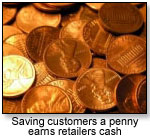 Perception has fascinated retailers for at least 100 years, when it was realized that customers perceive prices ending in .99 to be significantly lower than a price just one cent higher. In 2005, Manoj Thomas and Vicki Morwitz conducted five experiments to determine why. Perception has fascinated retailers for at least 100 years, when it was realized that customers perceive prices ending in .99 to be significantly lower than a price just one cent higher. In 2005, Manoj Thomas and Vicki Morwitz conducted five experiments to determine why.
"First, this occurs only when the leftmost digits of the prices differ (e.g., $2.99 vs. $3.00)," they explained in the abstract of their study, "Penny Wise and Pound Foolish: The Left-Digit Effect in Price Cognition," which was published in the June 2005 edition of the Journal of Consumer Research. "Second, the left-digit effect also depends on the numerical and psychological distances between the target price and a competing product's price. The closer the two prices being compared, the more likely is the left-digit effect."
Though the .99 rule is well known, Wrzesinski's experience at the big-box store got him rethinking all of his pricing policies.
"I realized we can't look at pricing from our point of view; we have to look at it from the customer's point of view," he told TDmonthly. "From the customer's point of view, certain items didn't sell well at certain prices."
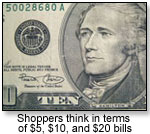 Customers Think With Bills Customers Think With Bills
Customers buying a gift in Wrzesinski's store often wanted to add on a "$5 rattle" to spruce up the package's wrapping, he realized.
"They'd always say a '$5 rattle,' not $3 or $4." And a $5 rattle meant one priced $4.99 or less; $5.99 was too expensive, because it required more than just a $5 bill. (Fig. 6.3)
"If they didn't find anything they liked for $5, they'd immediately jump to the idea of a $10 rattle," he said. "The reason they'd make that jump is because they think of the bill they pull out of their wallet. Although $5.99 is too much when they're thinking about spending $5.00, when they jump to the idea of a $10 bill, $5.99 looks too cheap and $7.99 looks better."
$2 More Is a Bargain
As an experiment, Wrzesinski took two boxes of Gund wrist rattles that had been priced at $5.99 and changed the price tag on one box to $7.99 and set them together side by side.
"We sold out of $7.99 rattles, but we didn't sell one piece of the $5.99 rattles — all because of customer perception," he said. The key to pricing, he advised, is to find the price that looks best to the customer.
Good Numbers, Bad Numbers
As Wrzesinski continued his experiments, he noticed that items with a "3" or "6" in them were not good sellers, attributing this to their association with "unlucky" numbers such as 13 and 666. Zero was also a "bad" number, because if something is $90.99, it's perceived to be less of a bargain than the same item priced at $99.99. Conversely, the numbers 4 and 9 are perceived as "good," except in Asian markets, where 4 is considered unlucky.
A Jump in the Profit Margin
"If the customer sees more value because the price looks better to them, the customer's happy, you're happy and the company's happy because you're selling more of [its] goods." — Phil Wrzesinski, Toy House and Baby Too
Since Wrzesinski instituted his price changes, he's noticed a nearly seven-point increase in his profit margin. At this point, he said, approximately 75 percent of the product in his 30,000-sq.-ft. store has been priced for the customer's point of view. However, he warned that certain commodities, such as Ganz's Webkinz, won't adhere to these guidelines, because customers are so familiar with their prices.
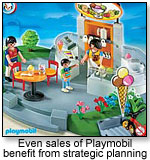 "Someone suggested we couldn't do it to Playmobil, since it's a commodity, but we did do it to Playmobil; we saw a 21 percent increase in sales and a 27 percent increase in profit," he said. No matter how high the price, "If the customer sees more value because the price looks better ... the customer's happy, you're happy and the company's happy because you're selling more of [its] goods." "Someone suggested we couldn't do it to Playmobil, since it's a commodity, but we did do it to Playmobil; we saw a 21 percent increase in sales and a 27 percent increase in profit," he said. No matter how high the price, "If the customer sees more value because the price looks better ... the customer's happy, you're happy and the company's happy because you're selling more of [its] goods."
TEACH THEM WHAT YOU KNOW
"[Seven-year-old Paige] is fabulous to take shopping for other children because she evaluates what and why they would like something." — Grandmother Ruth Mandt
When TDmonthly editor Susan Ledford asked Roundtable reviewers if the experience of being toy testers had changed them, Ruth Mandt reported that her grandchildren had increased in self-confidence, "since someone cares what they think." Her granddaughter Paige (then 7) "is fabulous to take shopping for other children because she evaluates what and why they would like something."
Rebecca Heinrich said of son Collin (3), "I think it has sharpened his sense of value, both in budget and play value."
Robbin Dawson said her son Ethan (9) learned that "his opinion has value and that being 'paid' does not necessarily involve money."
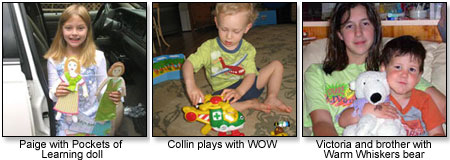
Bust the Hype
You can use your newsletter, blog and press releases to inform parents about how to help their children spot — and resist — the hype of heavily advertised mass-market toys and games. (see Turn Mass-Market Fanatics into Specialty Lovers)
"Younger kids do tend to fall for the promises made on the box and in the commercials," said Victoria Ledford (then 13).
The impact of packaging and advertising, especially TV commercials, is enormous on children, said Dr. Adele Schwartz, research director for Stars for Kidz, a market research company. "Parents need to be really cautious and make purchases wisely, and they need to find a way to make children more conscious. We don't invest enough in teaching children how to be wise consumers," she said.
"Aggressive marketing is a factor," explained Dawson of her children's requests for specific toys. Kathleen Tutone, owner of Treehouse Toys in Portsmouth, N.H., stated, "[Children] are bombarded with hype from television."
Sue Christensen, another toy tester, commented, "I talk to [my kids] about how advertising can make a toy look a lot cooler than it really is."
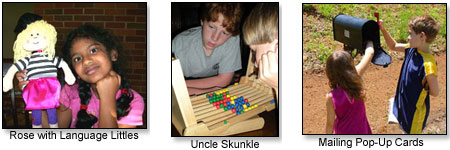
Dawson asks her children questions: "What is it made of (eco-friendly)? How well-made the toy is (durability)? How many ways you can play with the toy (versatility)?" She has found that "with toys that only have one use or one or two features, they'll have buyer's regret later."
Sponsor Toy Testing
Instead of holding a standard event in your store, turn the day into a toy testing event with children grading toys and games with stars or even writing their own reviews. Posting their comments in your store and in your newsletters and press releases will let them (and their parents) know that their opinions are important. (see What It's Like to Be a Toy Tester)
Actively listen to a child, suggested Tutone. "Communication is a two-way street, and you have to really listen to what their needs and wants are."
Jill Zuidema suggested having children do a comparison between several toys. The comments they make as they compare and contrast could be useful to you on your next round of ordering, too.
Ethan (then 9) and Sara (then 7) "have learned how to articulate their likes and dislikes more clearly," noted Dawson. They are also more liable to change a game's rules or a toy's intended use than prior to their Roundtable participation. "I suspect that talking so often about how test toys might be improved is the culprit," she said.
Victor (then 4) and Radina (then 11) strengthened their creativity as they came up with suggestions to improve games and toys and began "thinking beyond the game," pointed out their mom, Kostadinka Lilova.
"I'm still surprised when [children] generate such high-quality ideas and express what is capturing their attention," Dr. Schwartz commented. "Companies have learned to take more lead from kids and to listen to them very carefully."
Get Involved With Parents
You or one of your staff can make regular trips to local parents' groups and schools to spark discussions about toys, or even bring samples of products for them to evaluate.
"I have given more thought to my own purchases," commented Heinrich about her experience as a toy tester. Mandt is more likely "to consider the way the child will interact with the toy more" as a result of her experience. Lilova agreed: "We actually have started paying more attention to the specific toy the kids were playing with [and] why she/he plays with this toy." She concluded, "It is important for the parents to be part of the kids' imaginations by discussing their toys and games."
Ecologically minded Dawson looks more closely at what materials are used to manufacture products. "Toy testing has firmly established the habit," she stated. Teresa Wilson now routinely consults a website, if available, before purchases. She also more consistently looks at a toy's intended age range and number of players.
Retailer Collette Shockley pays more attention to others' opinions since she began reviewing toys for TDmonthly. "Economically, price makes a difference in purchases, but children really enjoy the quality dolls more," she learned.
HOW YOU'LL BENEFIT
Understanding why they respond to one toy rather than another expands a child's awareness of his or her own needs, and increases the likelihood that the next toy chosen will have lasting value.
Packaging Gets Read
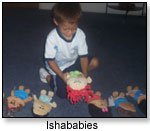 Wilson now sees her children looking more closely at packaging as a result of their Roundtable participation. "They tend to look for pictures of the items and/or description of contents, which had not occurred to them previously," she pointed out. But they also learned not to "judge a toy based on packaging and/or website," and, as a result, "they do not automatically discount a toy based on suggested age of user," she said. Wilson now sees her children looking more closely at packaging as a result of their Roundtable participation. "They tend to look for pictures of the items and/or description of contents, which had not occurred to them previously," she pointed out. But they also learned not to "judge a toy based on packaging and/or website," and, as a result, "they do not automatically discount a toy based on suggested age of user," she said.
Though Jonathan (then 9) will only look at the packaging closely if his interest is initially engaged, reported Veronica Flamenco, brother Matthew (then 11) reads the packaging first before deciding if he is interested in the toy.
Virginia Davis, writer for TDmonthly's Dolls Roundtable, said of her granddaughters, "They ask their own questions about the toys they play with or want to purchase." Lilova reported that her children now pay more attention to the purpose of a game/toy.
Parents Become Involved
Analyzing toys helps parents recognize what qualities keep a child interested in a toy for the long term.
"Part of what makes a toy or game a perennial around here is easy set-up and clean-up, a good mix of luck and skill, and humor potential," commented Christensen. Wilson pointed out open-ended play and versatility of play as qualities that retained her children's interests in a specific toy.
"The toys that stay with my kids are the interactive ones — a craft set of some sort, a game we can play together," said Gail Richardson. (Sidebar 6.3 The Toys We Keep) Dawson added, "Ethan (then 9) is still very much into competitive play, (interaction with other children comes into play), so he enjoys board games with skill (rather than chance) involved." Zuidema commented, "Most of what we get are things that will last through several years of interest."
Wilson said, "I've found that my perception of what a toy should cost may not be contemporary with today's market."
Kids Learn
Even after toy testing, a kid might still fall for the latest fad on TV or a toy at a friend's house.
"If a toy is disappointing, the child will learn from that," said Dawson. "It's an inexpensive lesson for the children."
Thirteen-year-old Victoria agreed: "An occasional hard lesson learned is worth it in the end."
Other contributors to this article may have included: Julie Adrian • Michaele Birney Arneson • Leigh Au • Christina Chan • Julia Ann Charpentier • Elizabeth Chretien • Virginia Davis • Laurel DiGangi • Zan Dubin Scott • Lisa Durante • Cicely Enright • Margaret H. Evans • Doug Fleener • Diane Franklin • Janie Franz • Dennis Foley • Dennis Furlan • Rosette Gonzalez • Elizabeth Greenspan • Mort Haaz • Sharri Hefner • Terri Hughes-Lazzell • Kyle Hall • Pennie Hoover • Sheri Jobe • Julie L. Jones • Candyce Kornblum • Christine Lebednik • Susan Ledford • Chris Lundy • Susan Maddela • Hans C. Masing • J.D. Meisner • Adeena Mignogna • Catherine Jo Morgan • Claudia Newcorn • Willow Polson • Marie Raven • Kara Revel • Andrew Robinton • Greg Rock • Brenda Ruggiero • Tamara Schuit • Brent Turner • Vanessa VanderZanden • Jodi M. Webb • Stacy Wiebe• Mark Zaslove • Alex Zelikovsky
 Writer's Bio: Writer's Bio: ALISON MAREK is an award-winning writer, director and cartoonist whose work has been published by Fairchild Publications and DC Comics (Piranha Press), broadcast on Showtime and other cable networks, and viewed worldwide in film festivals. See her short films and print work on www.alisonmarek.com. Watch her nefarious villains in the web series www.MuggsMovers.com. Get inspired by her cartoons "Daily ARFFirmations to Unleash Your Inner Fido" at www.ARFFirmations.com. Phew! And then ... Read more articles by this author
THIS BANNER IS AN AD:

Back to TDmonthly's front page
|  |
Advertise on TDmonthly

|

